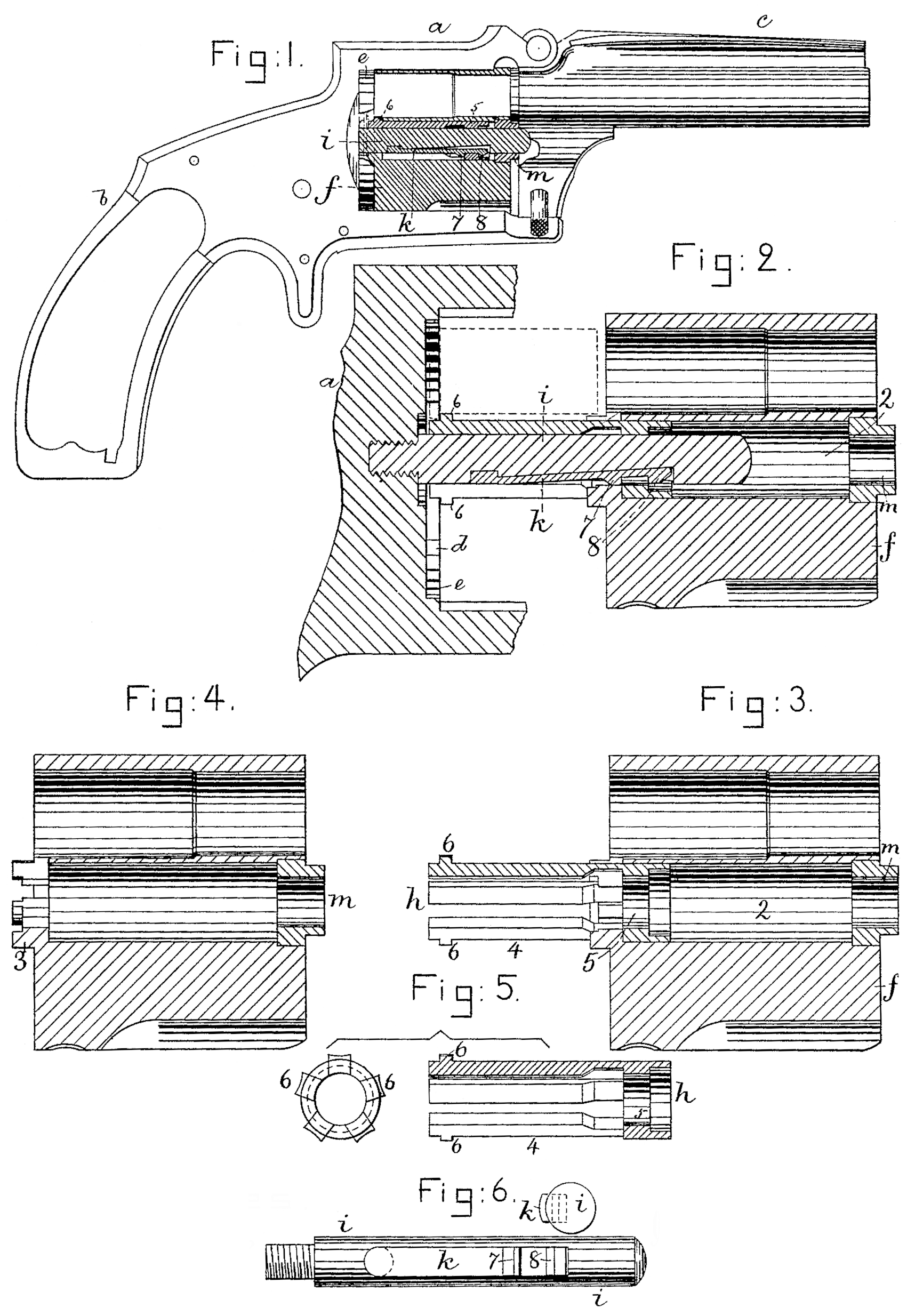US 222065
UNITED STATES PATENT OFFICE.
JOHN M. MARLIN, OF NEW HAVEN, CONNECTICUT.
IMPROVEMENT IN REVOLVING FIRE-ARMS.
Specification forming part of Letters Patent No. 222,065, dated November 25, 1879; application filed July 15, 1879.
To all whom it may concern:
Be it known that I, John M. Marlin, of New Haven, county of New Haven, State of Connecticut, have invented an Improvement in Extractors for Revolving Fire-Arms, of which the following description, in connection With the accompanying drawings, is a specification.
This invention relates to extractors for revolving fire-arms; and it has for its object the production of a simple and efficient device for that purpose.
In this, my invention, I employ a skeleton sleeve composed of a collar and parallel arms provided with cartridge-engaging projections, the collar engaging a series of radial projections within the central bore of the revolving cylinder; and in connection with the skeleton sleeve I employ a spring-latch attached to the stud or pin which supports the revolving cylinder, the said spring-latch engaging the sleeve-like extractor and simultaneously drawing outward with the extractor all the cartridge-shells as the revolving cylinder is with drawn from the stud.
Figure 1 represents, in side elevation, a revolver provided with my improved cartridge extractor, the revolving cylinder, its supporting-stud, and extractor being in longitudinal section. Fig.2 shows, in longitudinal section, a sufficient part of the revolver to represent the cylinder drawn forward and the extractor drawn out. Fig. 3 represents the revolving cylinder and extractor in longitudinal section. Fig. 4 shows a like section of the cylinder alone; Fig. 5, a longitudinal section and end view of the extractor; and Fig. 6, a top and end view of the stud to hold the cylinder and the spring-latch to engage and draw out the extractor.
The frame-work a, handle-piece b, and barrel c of the revolver are of usual construction. The breech-piece d has about it an annular flange, e.
The cylinder f, made to revolve in any usual Way, has at one end of its central bore, 2, a series of radial projections, 3, (see Fig. 4.) which are located between the arms 4 of the extractor h.
The extractor is a device which resembles a skeleton sleeve, and it is composed, essentially, of a cylindrical or annular collar or part, 5, and a series of parallel arms, 4, projecting therefrom, each provided with a cartridge-engaging projection, 6, which projections, when the extractor is inserted within the bore 2 of the cylinder, as in Fig. 1, fall below the rims or flanges of the cartridges, (one of which is shown in dotted outline,) so as to draw them out, as represented at Fig. 2, when the said cylinder is drawn outward along the stud i, or therefrom, the said stud being attached to the frame-work of the revolver in any usual way. This stud has a spring-latch, k, provided with double inclines 7 8, in order that the latch may snap over the collar 5 of the extractor as the cylinder is forced upon the stud, so as to engage and draw out the extractor and cartridges or shells whenever the cylinder is drawn from the stud i.
Just before the cylinder is withdrawn from the stud (see Fig. 2) the incline 7 of the latch or catch meets a fixed part, 3, of the cylinder, which crowds the latch inward and disengages it from the collar 5, when the cylinder and its connected extractor may be removed from the said stud preparatory to reloading.
I am aware that an extractor has been connected with the supporting-stud of a revolver cylinder, as in United States Patent No. 144,815. In this my invention the extractor itself forms the bearing upon which one end of the cylinder revolves, while a tubular nut, m, screwed into the cylinder, serves as a bearing for and receives the outer end of the stud i. The radial projections 3 striking the collar prevent the complete withdrawal of the extractor from the cylinder.
I claim—
1. The combination, with the stud i, its latch, and the cylinder, of the sleeve-like extractor, fitted within and located between the cylinder and stud, substantially as described.
2. The cylinder and a projection, 3, to stop the outward movement of the extractor, and the stud i, provided with the spring-latch k, adapted to enter and engage the extractor, combined with the skeleton sleeve-like extractor h, composed of an annulus or collar, 5, and a series of separate parallel arms, 4, connected there with, each provided with projections to engage and remove the cartridge shells, substantially as described.
3. In a revolving fire-arm, the sleeve-like extractor h, pin i, and spring-latch k, to engage the extractor and withdraw it from the cylinder, combined with the cylinder and a projection thereon, to disengage the latch from the extractor during the outward movement of the cylinder, substantially as described.
In testimony whereof I have signed my name to this specification in the presence of two subscribing witnesses.
JOHN M. MARLIN.
Witnesses:
James Reynolds,
Wm. H. Ward.

